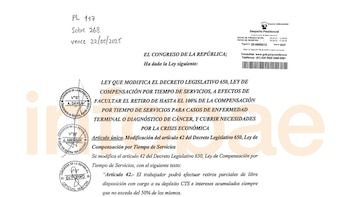On Biguarte It has even Thursday May 22 To decide on the law of CTS Retreat. The two options you have are or promulgate the standard or observe it.
The first implies that it be published in the Official Gazette The Peruvian and in the course of 10 days the Ministry of labor promulgate the regulation for access, but the other option would mean returning the proposal to Congress and would take the deadline for a few days.
Thus, finally, when could the CTS be withdrawn, considering both options? According to Jorge Carrillo Acosta, Professor and Finance Expert from Pacific Business School, at best, access PI hate to get effective on Thursday, May 15in case the president does not take the entire period to promulgate it.

After the autograph of the CTS Retirement Law – that authorizes, among other things, the release of 100% of the funds of the accounts until December 31, 2026 – will reach the Executive, delay of the Congress in signing it through, now the days are counted for its implementation.
According to Jorge Carrillothe next steps that this law would follow would be the following:
- First, the Executive must review the standard. For which it has a period of 15 useful days, which they sell on Thursday, May 22.
- However, for this there are two alternatives: 1) that the Executive promulgates the standard, YS), that the Executive observes the norm
- But in the case of observing, the Plenary of the Congress could approve it by insistence, which would take approximately one more week
- Once this law was approved, it would have to be published in the Official Gazette The Peruvian
- A Starting from this, the last step would also be the elaboration and publication of the corresponding regulation, for which the Ministry of Labor and Employment Promotion has a period of 10 calendar days
Thus, at best, according to Carrillo, workers can withdraw their CTS amounts of its accounts on May 15, which is just the maximum date that employers have to deposit the first of these amounts of this 2025.

However, “in the worst case it could take until the second week of June”, Clarifies the expert.
As is known, this would be the second time that On Biguarte Validate a rule like this: last year access was approved until December 31 of that year.
In 2024, the Congress approved the rule on a Thursday, May 2, the president received it the next day, and promulgated the standard on Friday, May 17, in just 10 business days. And then in 9 calendar days the MTPE had already published the standard.
If this 2025 the same deadlines were followed, Boluarte would promulgate the standard on Thursday, May 15 and Saturday, May 24, the MTPE Regulation. In this scenario, workers could withdraw their CTS since Sunday, May 25.

The Retirement Law CTS approves free access to the accounts that keep the amounts of this “unemployment insurance” Until December 31, 2026.
In addition to this, the valid norm that can always be access half of the amounts saved In these accounts, what changes the figure of this labor law. Since workers will have free access, this measure may be used since January 1, 2027, although for those who have withdrawn all their amounts, they will possibly have to wait for the next deposit.
Also, in case of terminal disease o Cancer, workers can get 100% of these amounts.

On May 15, it marks the last day for companies to pay compensation for service time (CTS). Those that do not comply with this period could face significant sanctions, which will depend on the severity of the infraction. According to the Chamber of Commerce of Lima (CCL), fines could reach up to S/ 139,742 in case of non -compliance.
If companies do not deliver the liquidation sheet within five days of the deposit, The fine could be up to S/84.102, a minor sanction. This regulation affects all companies, regardless of their size, and will be supervised by the National Superintendence of Labor Supervision (Sunafil). This entity applies different levels of fines, which vary according to the size of the company, dividing them into microenterprises, small and medium -sized companies or large companies, adjusting the sanction according to the sector and the number of workers affected.











